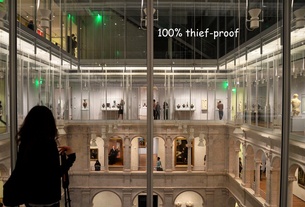{shortcode-abbc25199304960017e84bf73e8f4c6b12961d1e}
When a Harvard College junior was handcuffed and loaded into a Harvard University Police Department van outside of Massachusetts Hall, observers knew that the arrest, which ended a blockade of top administrators’ offices, indicated that on-campus activism for fossil fuel divestment had so far reached its peak.
The increasingly visible activism, which mirrors similar movements across the country, comes after a year in which the University announced a series of high-profile, sustainability-focused initiatives—first the creation of a vice president of sustainable investing role within the Harvard Management Company, which invests Harvard’s endowment, and, more recently, Harvard’s signature on the United Nations-backed Principles for Responsible Investment.
Yet some members of the community remain unsatisfied, saying that Harvard, in the process of balancing sustainability and financial concerns, is ignoring a moral obligation to remove itself from a fossil fuel industry causing harm to humanity on a global scale. The decision to divest, they say, would follow in the footsteps of Harvard’s decision to do so for social or political reasons on previous occasions, some of which were spurred by student and alumni activism.
This disconnect between a university that believes it is taking significant strides on the sustainability front and members of the community that continue to push for more—is rooted in two fundamentally different conceptions of the meaning of responsible investment. Widening the gap is what some characterize as an eroding mechanism for incorporating student feedback into investment decisions.
THE BOTTOM LINE
University leaders have framed HMC’s commitment to environmental, social, and governance, or ESG, considerations not as a broad moral or political statement but instead as a prudent financial decision, especially in the context of the company’s status as a long-term investor of Harvard’s $32.7 billion endowment, which is the largest of any institution of higher education in the world.
{shortcode-05d13bd858337d3397fc29c8204feb9797d0af0a}
When it was founded in 1974, HMC was tasked with managing a significant portion of the University’s endowment in-house, with the belief that their own managers could create higher returns than the traditional third-party asset managers. Since then, the company has long emphasized alternative asset classes, like private equity, natural resources, and real estate—a sharp departure from the traditional bond and stock-heavy portfolios of most university endowments.
This unique history has shaped how HMC has answered the challenge of the responsible investment movement.
Today, HMC leaders say that they consider environmental, social, and governance factors as some among many indicators of the long-term profitability of an investment.
For example, according to Jameela Pedicini, the recently hired vice president for sustainable investing at HMC, “Health and safety issues and also labor standards can play a real role in how you value a company, and ne can see that one company that has ESG performance, so here, having a good health and safety record and good labor relations, was actually performing better than a company that didn’t.”
Pedicini’s position, which was created last February, is often cited as evidence of the company’s increasing commitment to ESG factors. She says that she is responsible for reviewing Harvard’s investments with an ESG lens and advising HMC investment managers on sustainable practices. Exactly what these practices entail, she adds, differs depending on the specific asset class.
{shortcode-a2019f48d26abf20ceb8e2339bb6ead9f3d20ce5}
With wholly-owned alternative assets, for example, HMC aims for compliance with industry-specific ESG standards.
“We’ve always tried to manage our forests to standards that at least could be certified by a third party auditor,” Andrew G. Wiltshire, head of alternative assets at HMC, says.
He said that HMC takes a similar approach across all assets in the natural resource portfolio.
“We’ve looked for certification schemes that provide similar kind of assurance that what we do, according to a third party independent source, is considered first class, genuinely sustainable, and good for all stakeholders involved,” he says.
Yet HMC officials are careful to not attribute this focus on ESG standards to a deeper social role of the endowment’s investments. When asked how moral imperatives played into responsible investing, Pedicini responds by only discussing the long-term financial benefits of ESG concerns.
{shortcode-539c3ec8471bf410195b539d0061d9e82d182fea}
On the topic of the fossil fuel industry, University President Drew G. Faust has long acknowledged that Harvard as a research institution has an important role to play in combating climate change, but she has said repeatedly that manipulating the endowment should not be part of those efforts.
“The endowment is a resource, not an instrument to impel social or political change,” Faust wrote in an open letter to the Harvard community in October 2013, as she explained the University’s stance against fossil fuel divestment.
DRAWING THE LINE
Voices on and off Harvard’s campus believe that every one of HMC’s investment decisions carries certain serious political and social ramifications. Given that the significance of the endowment expands beyond Harvard’s balance sheet into the outside world, they argue, the University should ensure that its investments reflect the ethical outlook of the broader campus community, which includes students, faculty, and alumni.
{shortcode-84839ca4fddf33e12707df417e23496daaa06f84}
David Wood, director of the Initiative for Responsible Investment, a research organization housed in the Hauser Institute for Civil Society at the Kennedy School, argues that, regardless of how vocal these groups are, there will always be a moral boundary that, even if unacknowledged by officials, will rein in investment activities.
“One way to think about this is to acknowledge the implicit limits to what people would find acceptable,” Wood says. “No one now presumably in this kind of space would invest in the slave trade in order to make a profit, even if it was the best returning investment out there. Everyone has a limit and the question is, where do you set it?”
Whether for financial or political reasons, the University has in the past divested its endowment from interests that broad swaths of Harvard’s stakeholders found objectionable. Specifically, University leaders removed investments in some companies doing business in apartheid South Africa in 1978, from tobacco companies in 1990, and from PetroChina, an oil company with close ties to genocide-ridden Sudan, in 2005.
In making the decision to divest from tobacco companies, then-president Derek C. Bok expressed justification on a social justice platform.
The move, he said, according to a New York Times article at the time, “was motivated by a desire not to be associated as a shareholder with companies engaged in significant sales of products that create a substantial and unjustified risk of harm to other human beings.''
{shortcode-6a801dacb024707d2dde69f88feb9b03c8aa6a56}
In the view of today’s advocates for restricting investment practices, the academic and ethical mission of universities in general cannot be separated from the mission of HMC.
“Ultimately, as an educational institution, Harvard has a unique role as a thought leader and as an action leader,” says Sam F. Wohns ’14, a co-founder of the Responsible Investment at Harvard Coalition, a group that has recently expressed concerns about HMC-owned timberlands in Argentina—accusations that Wiltshire has repudiated.
“We want to make sure Harvard is upholding its role as a thought and action leader,” Wohns says.
Furthermore, some argue that the unparalleled scope and size of the endowment give Harvard greater leverage to promote ESG causes as an influential shareholder—a role that Faust agreed should be used in a socially upstanding way in her open letter against divestment.
HMC is unique among university endowments in its diversification into alternative assets. As of 2013, according to HMC’s annual report, 13 percent and 10 percent of its assets were allocated to natural resources and real estate, respectively. According to many experts, because it owns most of these assets in full and thus has complete control over management decisions, Harvard has more of an ability to make a direct and immediate impact on ESG standards.
This status stands in contrast to smaller and more traditional endowments with a much larger allocation toward traditional stocks and bonds, which provide the investor with a claim to, at most, a rather insignificant portion of control over its company.
Marcie Hawkins Smith, executive director at the Responsible Endowments Coalition, suggests that Harvard holds considerable influence in the sphere of endowment investment on account of the unparalleled scale of its endowment, which is larger than the GDP of several dozen sovereign nations.
“The potential impact is really huge, if you’re talking about Harvard doing anything with respect to responsible investing,” Hawkins Smith said. “That has incredible ripple effects, not just within education but also across the pension fund space and across the foundation endowment space.”
TOEING THE LINE
At a time when Harvard’s endowment has the potential to shape national discussion on a contentious environmental issue, some say the number of voices at the table is small—smaller, even, than HMC claims.
According to Pedicini, HMC incorporates feedback from the broader university community through two main avenues: first, through the Advisory Committee on Shareholder Responsibility and the Corporation Committee on Shareholder Responsibility, which together form an oversight system created by HMC in 1974. The second channel of engagement, Pedicini says, is the the informal option open to student groups of sitting down with Pedicini herself.
As has been the case since the body’s inception four decades ago, the ACSR is tasked officially with making recommendations on proxy votes that come up for companies included in HMC’s public equity portfolio, which often, although not always, take up ESG concerns.
{shortcode-10fe81526aa87ee216dae951866a0d0a9b4f7f55}
But ACSR, which consists of four students, four faculty members, and four alumni, serves in merely an advisory role. The oversight process was designed so that the ACSR reports to the four members of the Corporation, the University’s highest governing body, who sit on the CCSR, and that the CCSR wields ultimate authority over any divestment decisions.
In recent years, however, the ACSR’s influence over the endowment seems to have further diminished. Public equities have decreased from 58 to 33 percent of the portfolio since 1995, and the CCSR has voted on fewer and fewer resolutions, dropping from 157 votes in 2004 to 56 in 2013, according to the 2012-2013 CCSR annual report.
As frustration with HMC’s institutional mechanisms for incorporating student input has mounted, HMC leadership has addressed the responsible investment movement with an approach that is subtly but nonetheless fundamentally distinct from the thought process of student activists.
While HMC, like the student activists who criticize it, has stressed the importance of ESG factors in its decision-making processes, in focusing on long-term profitability instead of values, it has framed this importance in a different light than those students.
“A lot of values talk is being buried into a business case frame,” Wood says. “There are places when [ESG and profit] overlap, but also, it’s just a more comfortable frame to have this investment discussion.”
—Staff writer Christine Y. Cahill can be reached at christine.cahill@thecrimson.com. Follow her on Twitter @cycahill16.
—Staff writer Sonali Y. Salgado can be reached at sonali.salgado@thecrimson.com. Follow her on Twitter @SonaliSalgado16.


